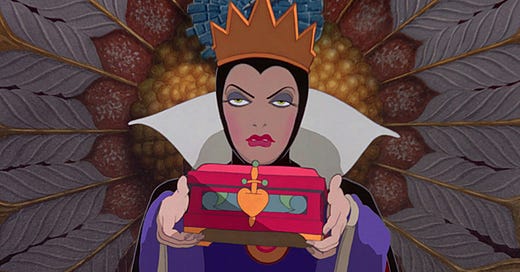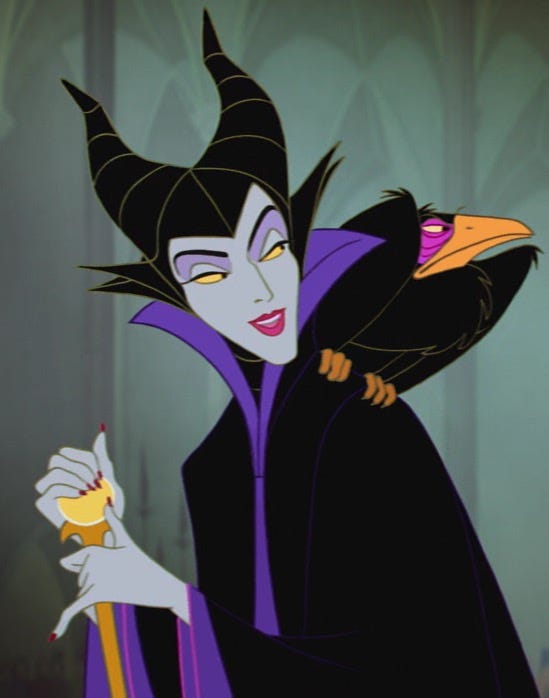Sinful Sunday: The Beautiful Badness of Disney's Early Villains
The Evil Queen, Lady Tremaine, and Maleficent are reminders of how the studio once excelled at crafting compelling villains, many of whom would go on to have extensive queer afterlives.
Hello, dear reader! Do you like what you read here at Omnivorous? Do you like reading fun but insightful takes on all things pop culture? Do you like supporting indie writers? If so, then please consider becoming a subscriber and get the newsletter delivered straight to your inbox. There are a number of paid options, but you can also sign up for free! Every little bit helps. Thanks for reading and now, on with the show!
Welcome to “Sinful Sundays,” where I explore and analyze some of the most notorious queer villains of film and TV (and sometimes literature, depending on my mood). These are the characters that entrance and entertain and revolt us, sometimes all three at the same time. As these queer villains show, very often it’s sweetly good to be bitterly bad.
When it comes to queer villains, Disney really does seem to have cornered the market. I’ve already written here at Omnivorous about some of my faves–Prince John, Jafar, etc.--and there’s a veritable cottage industry of online commentary centered on drawing out the complexities of the studio’s long list of queer baddies. By this point, I’ve actually lost count of the number of think pieces that have been published grappling with just this subject, but the preponderance of hot takes on the subject suggests that there are a lot of people out there who have a significant investment in Disney’s queer villains.
Today I’m going way back in the history of the studio to take a look at three powerful queer villainesses who, though not explicitly queer in the text (or even really coded as such) have nevertheless exerted a strong fascination on queer babies everywhere. I refer, of course, to the unholy trio of evil queens and stepmothers from Snow White and the Seven Dwarfs, Cinderella, and Sleeping Beauty. The Evil Queen, Lady Tremaine, and Maleficent set a very high bar for subsequent Disney villains in terms of both their queer appeal and their general bitchery and, though they’ve certainly been matched, they’ve never been exceeded.
Let’s start with the Evil Queen of Snow White. It’s quite easy to see why she would become so beloved of subsequent generations of queer audiences, with her rich voice with its hint of menace, her killer wardrobe, and her utter determination to destroy the young woman who has robbed her of the crown of being the fairest of them all. Is she petty? Yes, absolutely, but that’s part of what gives her character its queer bite, for what homo amongst us hasn’t wanted, at some point or another, to lash out against the pretty straight girl who seems to get everything handed to her on a silver platter? She’s also a mistress of disguise, and you have to give her props for being willing to totally give up her beauty in order to masquerade as an evil hag with a batch of poisoned apples on her arm.
The Evil Queen set the stage for many villainesses to follow, including Lady Tremaine, the threat who looms over all of Cinderella. Now, I’ve never been the biggest fan of this particular Disney feature, but I have to admit that Lady Tremaine is a highlight. She’s cold and imperious and utterly ruthless when it comes to making sure that her unruly (and not terribly bright) daughters get the best care that they can, for all that they are far more uncouth and unpleasant than their younger stepsister, Cinderella. As the kids say, she’s always serving c**t, whether it’s lying in bed with her cat Lucifer on her lap or simply sneering in contempt. Unlike the Evil Queen, there is at least some motivation for Lady Tremaine’s horrible behavior toward her stepdaughter. When it comes right down to it, she really does seem to want what’s best for Drizella and Anastasia (though it probably goes without saying that they absolutely do not deserve this).
And then there’s Maleficent.
For many reasons I’ve always found myself drawn to this badass sorceress with the horned headdress. Part of my attraction, to be sure, stems from the fact that she is voiced by Eleanor Audley, whose patrician tones were seemingly designed to play iconic Disney villainesses (including, it’s worth noting, Lady Tremaine). Like her predecessors, she also has a sense of style, with her flowing robes of black and purple and this, combined with her formidable power of sorcery, makes her one of the baddest bitches to have appeared in a Disney movie. As with the Evil Queen, there’s also something more than a little queer about her shapeshifting abilities, whether it’s transforming herself into a small ball of light to lure Aurora to her doom or metamorphosing into a giant dragon that comes perilously close to snuffing out the film’s hero, Prince Phillip.
Of the three big baddies of Disney’s Golden Age, Maleficent’s ire is arguably the hardest to pin down. Is she really that pissed off about not being invited to the birth of a princess that she would curse said royal to perish by pricking her finger on a spinning wheel? As I’ve written so often here before, though, there’s a certain pleasure that queer audiences can take in a ruthless woman behaving badly just because they can. And I’m sure I’m not the only baby queer who felt more than a little thrill when she managed to tie up Prince Phillip, arguably one of the hunkiest of the early Disney princes.
All three of these figures have had remarkable queer afterlives. Obviously drag culture has been quite explicit in its reliance on these badasses, which is entirely understandable. They’re beautiful, obviously, but they’re also in some ways exaggerations of traditional female beauty. In other words, they lend themselves to camp, and this is as true in more traditional drama as it is in drag. Lana Parrilla, for example, takes a bite out of her role of Regina/The Evil Queen in Once Upon a Time, and Cate Blanchett does something similar in her turn as Lady Tremaine in the remake of Cinderella. The new live-action Snow White certainly looks like it’s going to mark a nadir for the studio in terms of the quality of its remakes, but if nothing else Gal Gadot’s performance (assuming it’s as wooden in the actual movie as it is in the trailer) will lend itself to all sorts of camp appropriation.
Of the three, Maleficent has arguably had the most enduring queer afterlife, getting not one but two feature films of her own, both of which are, I think it’s safe to say, very queer in orientation and sensibility. To begin with there’s the fact that she’s played by none other than Angelina Jolie, one of the most noted queer icons of her generation. For another, there’s also the fact that this iteration of the character ends up forging a rather touching bond with the young Aurora. Whatever its other failings–and there are a lot, as I’m sure I’ll write about at some point here at Omnivorous–the Maleficent films at least deserve credit for being willing to give this character some development and a backstory that feels resonant and authentic.
I could go on and on about how much I absolutely adore these queer villains and how I pretended to be at least one of them numerous times during my childhood. Suffice it to say that I spent many yours as a child pretending to be the Evil Queen, Lady Tremaine, or Maleficent, flouncing around as if I had my own draperies flowing behind me. Imagining myself in their shoes was a way of escaping my humdrum everyday life, to be sure, but it was also something deeper and more empowering, an embrace of that which was disruptive and sometimes destructive. Even though I wouldn’t recognize it for what it was for years to come, inhabiting these female icons of villainy was a way for me to explore my nascent queerness. As such, they hold a very special place in my heart. As Disney drifts further and further away from its roots and robs its villains of their subversive queerness, I’ll keep returning to these badass bitches, reminders of a time when the studio wasn’t afraid to take risks and when it was capable of giving us villains who stayed with us long past the moment when the film ended.
So, here’s badass bitches of early Disney. Long may they reign.






